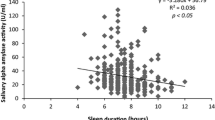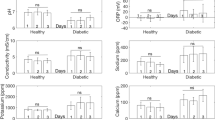Abstract
The aim of this study was to evaluate pain perception in epileptic children during an invasive procedure as the collection of venous blood through salivary alpha-amylase (sAA) activity determination, and to compare it with that of healthy children. In the study 23 children, 12 with epilepsy and 11 healthy controls were enrolled. From all children of both groups, one sample of saliva was collected through a non-invasive device, 15 min before (t 0), during (t 1), and 15 min later (t 2) blood withdrawal, and sAA activity was then determined through a kinetic-colorimetric assay. A statistically significant difference (p < 0.001) was found at t 2 between the sAA activity in the two groups, suggesting that epileptic children have an increased sensitization to pain, while at t 0 the difference was at the limit of statistical significance and at t 1 no statistically significant difference was found indicating that in both groups the venipuncture equally induced a state of stress. Our data suggest that sAA activity could represent a new objective and non-invasive biomarker for the assessment of pain perception in epileptic children.


Similar content being viewed by others
References
Merskey H, Albe-Fessard D, Bonica JJ et al (1979) Pain terms: a list with definitions and notes on usage. Recommended by the IASP subcommittee on taxonomy. Pain 6:249–252
Schechter NL (1989) The undertreatment of pain in children: an overview. Pediatr Clin N Am 36:781–794
Franck LS, Greenberg CS, Stevens B (2000) Pain assessment in infants and children. Pediatr Clin North Am 47:487–512
Treadwell MJ, Franck LS, Vichinsky E (2002) Using quality improvement strategies to enhance pediatric pain assessment. Int J Qual Health Care 14:39–47
Oberlander TF, Gilbert CA, Chambers CT et al (1999) Biobehavioral responses to acute pain in adolescents with a significant neurologic impairment. Clin J Pain 15:201–209
Breau LM, Camfield CS, McGrath PJ et al (2003) The incidence of pain in children with severe cognitive impairments. Arch Pediatr Adolesc Med 157:1219–1226
Stallard P, Williams L, Lenton S et al (2000) Pain in cognitively impaired noncommunicating children. Arch Dis Child 85:460–462
Hunt A, Goldman A, Seers K et al (2004) Clinical validation of the paediatric pain profile. Dev Med Child Neurol 46(1):9–18
Craig KD, Badali MA (2004) Introduction to the special series on pain deception and malingering. Clin J Pain 20:377–382
Beyer JE, Aradine CR (1987) Patterns of pediatric pain intensity: a methodological investigation of a self-report scale. Clin J Pain 3:130–141
Wong DL, Baker CM (1988) Pain in children: comparison of assessment scales. Pediatr Nurs 14:9–17
Miro J, Huguet A (2004) Evaluation of reliability, validity, and preference for a pediatric pain intensity scale: the Catalan version of the Faces Pain Scale—Revised. Pain 111:59–64
Fanurik D, Koh JL, Harrison RD et al (1998) Pain assessment in children with cognitive impairment. An exploration of self-report skills. Clin Nurs Res 7:103–119
Giusiano B, Jimeno MT, Collignon P et al (1995) Utilization of a neural network in the elaboration of an evaluation scale for pain in cerebral palsy. Methods Inf Med 34:498–502
Breau LM, McGrath PJ, Camfield CS et al (2002) Psychometric properties of the non-communicating children’s pain checklist-revised. Pain 99(1–2):349–357
Hunt A, Mastroyannopoulou K, Goldman A et al (2003) Not knowing-the problem of pain in children with severe neurological impairment. Int J Nurs Stud 40(2):171–183
Stallard P, Williams L, Velleman R et al (2002) The development and evaluation of the pain indicator for communicatively impaired children (PICIC). Pain 98(1–2):145–149
Terstegen C, Koot HM, de Boer JB, et al. Measuring pain in children with cognitive impairment: pain response to surgical procedures. Pain 103(1–2):187–98
Haruo S, Hisaki O (2002) The useful visual field and ERP topography in persons with intellectual disabilities. Int Congr Ser 1332:723–728
Kunihiro H, Atsushi O, Akihisa M (2003) Effect of aging on autonomic function in individuals with severe motor and intellectual disabilities. Brain Dev 25:326–329
Block AR (1981) An investigation of the response of the spouse to chronic pain behavior. Psychosom Med 43:415–422
Gilman SC, Fischer GJ, Biersner RJ et al (1979) Human parotid alpha-amylase secretion as a function of chronic hyperbaric exposure. Undersea Biomed Res 6:303–307
Chatterton RT Jr, Vogelsong KM, Lu YC et al (1996) Salivary alpha-amylase as a measure of endogenous adrenergic activity. Clin Physiol 16:433–448
Granger DA, Kivlighan KT, El-Sheikh M et al (2007) Salivary alpha-amylase in biobehavioral research: recent developments and applications. Ann NY Acad Sci 1098:122–144
Rohleder N, Nater UM, Wolf JM et al (2004) Psychosocial stress-induced activation of salivary alpha amylase: an indicator of sympathetic activity? Ann NY Acad Sci 1032:258–263
Conflict of interest
None.
Author information
Authors and Affiliations
Corresponding author
Rights and permissions
About this article
Cite this article
Ferrara, P., Bottaro, G., Angeletti, S. et al. Salivary alpha-amylase: a new non-invasive biomarker for assessment of pain perception in epileptic children. Acta Neurol Belg 113, 279–283 (2013). https://doi.org/10.1007/s13760-013-0180-z
Received:
Accepted:
Published:
Issue Date:
DOI: https://doi.org/10.1007/s13760-013-0180-z




